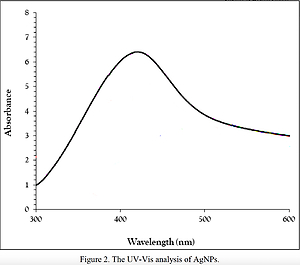Current issue
Archive
Manuscripts accepted
About the Journal
Editorial office
Editorial board
Section Editors
Abstracting and indexing
Subscription
Contact
Ethical standards and procedures
Most read articles
Instructions for authors
Article Processing Charge (APC)
Regulations of paying article processing charge (APC)
ONCOLOGY / EXPERIMENTAL RESEARCH
Preparation, characterization and investigation of the anti-human ovarian cancer activity of silver nanoparticles green-formulated by Salvia officinalis leaf aqueous extract
1
Department of Gynecology, Shaanxi Provincial People’s Hospital, Xi’an, China
2
Department of Botany and Microbiology, College of Science, King Saud University, Riyadh, Saudi Arabia
3
Department of Pediatrics, College of Medicine and King Khalid University Hospital, King Saud University, Riyadh, Saudi Arabia
4
Department of Radiation Oncology, Chungbuk National University, College of Medicine, Cheongju, Korea
5
Project Department, Zhongke Inno International Medical Research Institute, Beijing, China
Submission date: 2021-07-09
Final revision date: 2021-12-16
Acceptance date: 2021-12-18
Online publication date: 2022-01-06
Corresponding author
Gaofeng Zhang
Project Department, Zhongke Inno International Medical Research Institute, Beijing, China, China
Project Department, Zhongke Inno International Medical Research Institute, Beijing, China, China
KEYWORDS
TOPICS
ABSTRACT
Introduction:
In the present study, we decided to prepare and formulate a new chemotherapeutic drug (silver nanoparticles in aqueous medium using Salvia officinalis leaf aqueous extract) for the treatment of human ovarian cancer in in vitro conditions.
Material and methods:
Organometallic chemistry methods such as scanning electron microscopy (SEM), UV-visible spectroscopy (UV-Vis), and Fourier transformed infrared spectroscopy (FT-IR) were used to characterize silver nanoparticles. To investigate the antioxidant potential of AgNO3, Salvia officinalis aqueous extract, and silver nanoparticles, the DPPH test was used in the presence of butylated hydroxytoluene as the positive control. To survey the cytotoxicity and anti-human ovarian cancer activities of AgNO3, Salvia officinalis aqueous extract, and silver nanoparticles, MTT assay was used on human ovarian cancer cell lines i.e., Caov-3, SK-OV-3, and PA-1.
Results:
In UV-Vis, the clear peak at the wavelength of 421 nm indicated the formation of silver nanoparticles. In the FT-IR test, the presence of many antioxidant compounds with related bonds created excellent conditions for reducing silver in the silver nanoparticles. The silver nanoparticles inhibited half of the DPPH molecules at the concentration of 251 µg/ml.
Conclusions:
The best result of anti-human ovarian cancer effects of silver nanoparticles against the above cell lines was observed in the case of the SK-OV-3 cell line. Silver nanoparticles had very low cell viability and anti-human ovarian cancer properties dose-dependently against Caov-3, SK-OV-3, and PA-1 cell lines without any cytotoxicity towards the normal cell line (HUVECs).
In the present study, we decided to prepare and formulate a new chemotherapeutic drug (silver nanoparticles in aqueous medium using Salvia officinalis leaf aqueous extract) for the treatment of human ovarian cancer in in vitro conditions.
Material and methods:
Organometallic chemistry methods such as scanning electron microscopy (SEM), UV-visible spectroscopy (UV-Vis), and Fourier transformed infrared spectroscopy (FT-IR) were used to characterize silver nanoparticles. To investigate the antioxidant potential of AgNO3, Salvia officinalis aqueous extract, and silver nanoparticles, the DPPH test was used in the presence of butylated hydroxytoluene as the positive control. To survey the cytotoxicity and anti-human ovarian cancer activities of AgNO3, Salvia officinalis aqueous extract, and silver nanoparticles, MTT assay was used on human ovarian cancer cell lines i.e., Caov-3, SK-OV-3, and PA-1.
Results:
In UV-Vis, the clear peak at the wavelength of 421 nm indicated the formation of silver nanoparticles. In the FT-IR test, the presence of many antioxidant compounds with related bonds created excellent conditions for reducing silver in the silver nanoparticles. The silver nanoparticles inhibited half of the DPPH molecules at the concentration of 251 µg/ml.
Conclusions:
The best result of anti-human ovarian cancer effects of silver nanoparticles against the above cell lines was observed in the case of the SK-OV-3 cell line. Silver nanoparticles had very low cell viability and anti-human ovarian cancer properties dose-dependently against Caov-3, SK-OV-3, and PA-1 cell lines without any cytotoxicity towards the normal cell line (HUVECs).
Share
RELATED ARTICLE
We process personal data collected when visiting the website. The function of obtaining information about users and their behavior is carried out by voluntarily entered information in forms and saving cookies in end devices. Data, including cookies, are used to provide services, improve the user experience and to analyze the traffic in accordance with the Privacy policy. Data are also collected and processed by Google Analytics tool (more).
You can change cookies settings in your browser. Restricted use of cookies in the browser configuration may affect some functionalities of the website.
You can change cookies settings in your browser. Restricted use of cookies in the browser configuration may affect some functionalities of the website.



